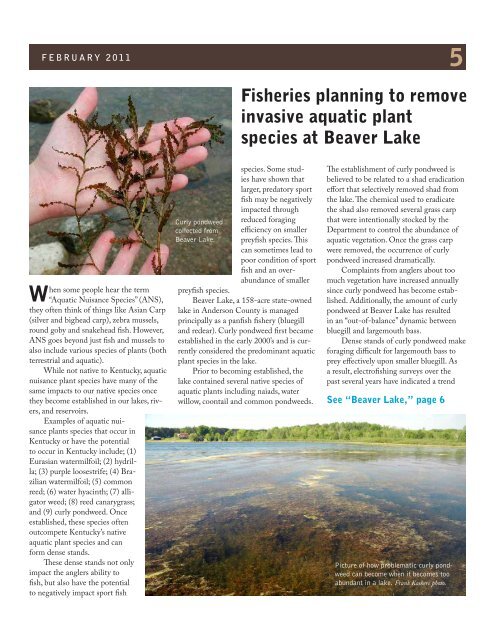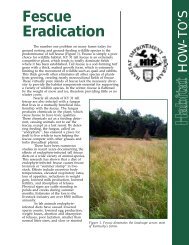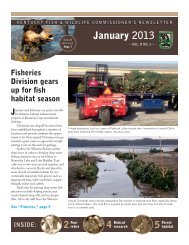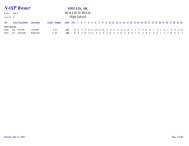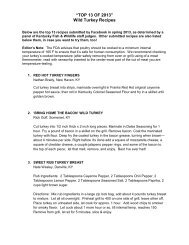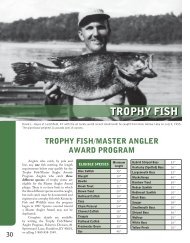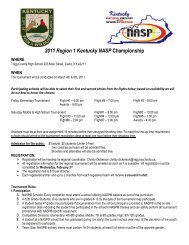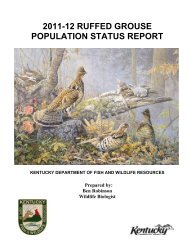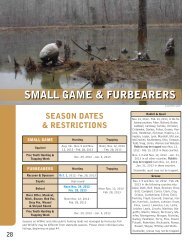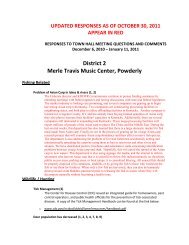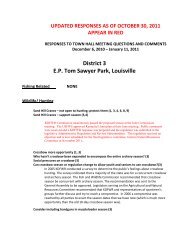February 2011 Newsletter - Kentucky Department of Fish and ...
February 2011 Newsletter - Kentucky Department of Fish and ...
February 2011 Newsletter - Kentucky Department of Fish and ...
You also want an ePaper? Increase the reach of your titles
YUMPU automatically turns print PDFs into web optimized ePapers that Google loves.
FEBRUARY <strong>2011</strong><br />
When some people hear the term<br />
“Aquatic Nuisance Species” (ANS),<br />
they <strong>of</strong>ten think <strong>of</strong> things like Asian Carp<br />
(silver <strong>and</strong> bighead carp), zebra mussels,<br />
round goby <strong>and</strong> snakehead fish. However,<br />
ANS goes beyond just fish <strong>and</strong> mussels to<br />
also include various species <strong>of</strong> plants (both<br />
terrestrial <strong>and</strong> aquatic).<br />
While not native to <strong>Kentucky</strong>, aquatic<br />
nuisance plant species have many <strong>of</strong> the<br />
same impacts to our native species once<br />
they become established in our lakes, rivers,<br />
<strong>and</strong> reservoirs.<br />
Examples <strong>of</strong> aquatic nuisance<br />
plants species that occur in<br />
<strong>Kentucky</strong> or have the potential<br />
to occur in <strong>Kentucky</strong> include; (1)<br />
Eurasian watermilfoil; (2) hydrilla;<br />
(3) purple loosestrife; (4) Brazilian<br />
watermilfoil; (5) common<br />
reed; (6) water hyacinth; (7) alligator<br />
weed; (8) reed canarygrass;<br />
<strong>and</strong> (9) curly pondweed. Once<br />
established, these species <strong>of</strong>ten<br />
outcompete <strong>Kentucky</strong>’s native<br />
aquatic plant species <strong>and</strong> can<br />
form dense st<strong>and</strong>s.<br />
These dense st<strong>and</strong>s not only<br />
impact the anglers ability to<br />
fish, but also have the potential<br />
to negatively impact sport fish<br />
Curly pondweed<br />
collected from<br />
Beaver Lake.<br />
species. Some studies<br />
have shown that<br />
larger, predatory sport<br />
fish may be negatively<br />
impacted through<br />
reduced foraging<br />
efficiency on smaller<br />
preyfish species. This<br />
can sometimes lead to<br />
poor condition <strong>of</strong> sport<br />
fish <strong>and</strong> an overabundance<br />
<strong>of</strong> smaller<br />
preyfish species.<br />
Beaver Lake, a 158-acre state-owned<br />
lake in Anderson County is managed<br />
principally as a panfish fishery (bluegill<br />
<strong>and</strong> redear). Curly pondweed first became<br />
established in the early 2000’s <strong>and</strong> is currently<br />
considered the predominant aquatic<br />
plant species in the lake.<br />
Prior to becoming established, the<br />
lake contained several native species <strong>of</strong><br />
aquatic plants including naiads, water<br />
willow, coontail <strong>and</strong> common pondweeds.<br />
5<br />
<strong>Fish</strong>eries planning to remove<br />
invasive aquatic plant<br />
species at Beaver Lake<br />
The establishment <strong>of</strong> curly pondweed is<br />
believed to be related to a shad eradication<br />
effort that selectively removed shad from<br />
the lake. The chemical used to eradicate<br />
the shad also removed several grass carp<br />
that were intentionally stocked by the<br />
<strong>Department</strong> to control the abundance <strong>of</strong><br />
aquatic vegetation. Once the grass carp<br />
were removed, the occurrence <strong>of</strong> curly<br />
pondweed increased dramatically.<br />
Complaints from anglers about too<br />
much vegetation have increased annually<br />
since curly pondweed has become established.<br />
Additionally, the amount <strong>of</strong> curly<br />
pondweed at Beaver Lake has resulted<br />
in an “out-<strong>of</strong>-balance” dynamic between<br />
bluegill <strong>and</strong> largemouth bass.<br />
Dense st<strong>and</strong>s <strong>of</strong> curly pondweed make<br />
foraging difficult for largemouth bass to<br />
prey effectively upon smaller bluegill. As<br />
a result, electr<strong>of</strong>ishing surveys over the<br />
past several years have indicated a trend<br />
See “Beaver Lake,” page 6<br />
Picture <strong>of</strong> how problematic curly pondweed<br />
can become when it becomes too<br />
abundant in a lake. Frank Koshere photo.


